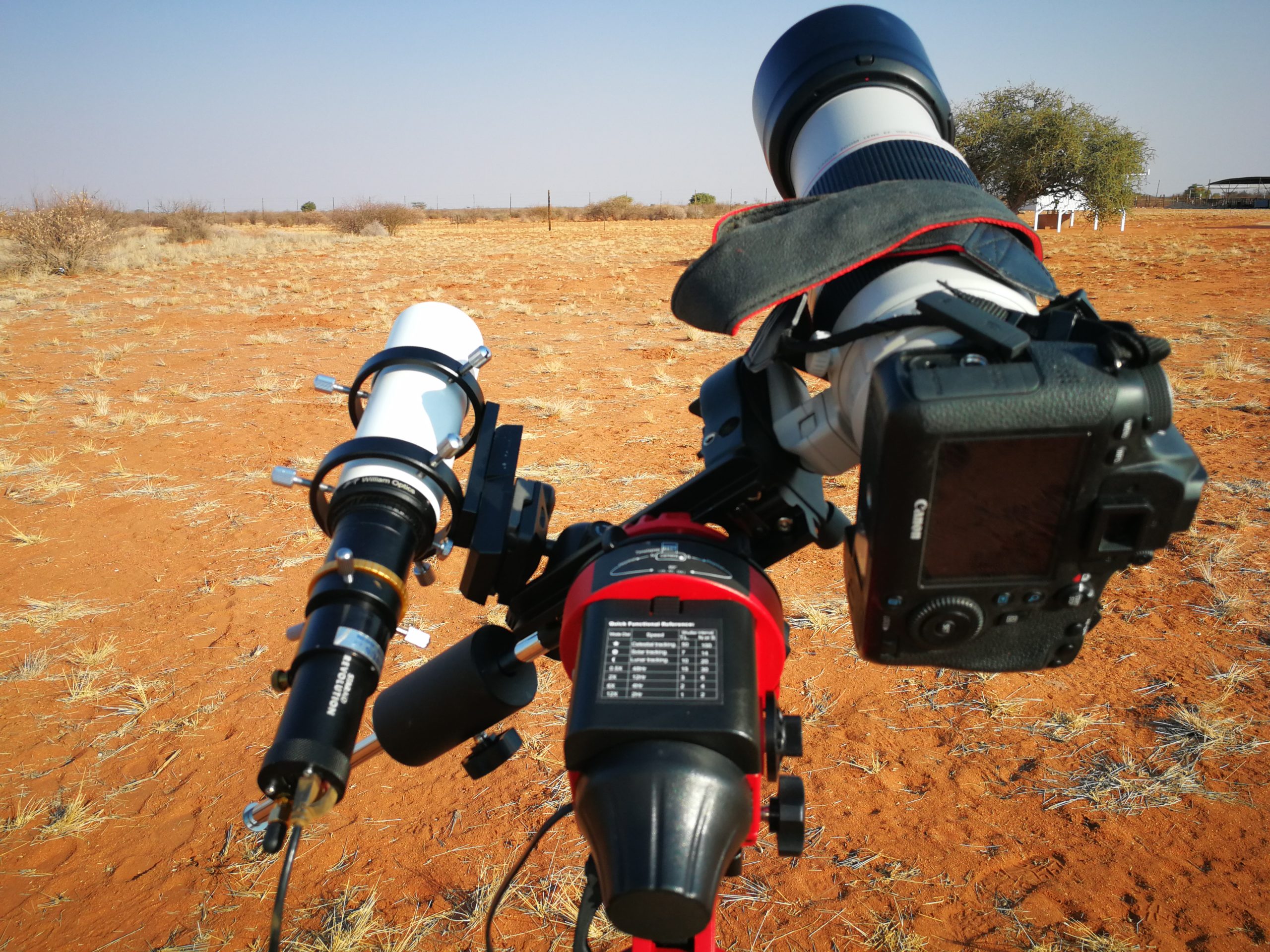In late July 2019 I traveled to Tivoli Farm in Namibia, to observe the wonders of the southern sky together with my good friend Luigi Fontana. This was my second stargazing trip to Namibia, eight years after the one of 2011. Since it was late July, I was better placed to observe some objects of the southern Milky Way, which were a bit higher in the sky just after sunset than in August.
Our imaging plan consisted of three sections: a wide-field program with a Baader-modified Canon 6D DSLR and a Canon 100-400 L IS II zoom lens, a medium-field program with a SBIG STL-11000 CCD and a Takahashi FSQ106 refractor (530 mm FL, 3.9° x 2.6° FOV), and a narrow-field program with a Moravian G2-8300 CCD and an Astro-Physics Starfire 127 refractor (1015 mm FL, 1.0° x 0.8° = 60’ x 45’ FOV). This post will focus on the wide-field part only, while the medium and narrow field program will be described in detail in a subsequent post.
First off, I must say that our preliminary planning activity had focused on the medium and wide field programs, while the wide-field was left to improvisation. I brought a Skywatcher Star Adventurer tracker along with my Canon 6D and my 100-400 zoom lens, just because “you never know :-) “, but I didn’t have a specific imaging plan. Using a heavy lens with focal lengths over 100-150 mm, autoguiding was a must, so I also brought my Lacerta MGEN stand-alone guider, which acted up on me on the first night. Fortunately our host, Reinhold, rented me a stand-alone camera, the StarAid Revolution, which was totally unknown to me. The StarAid revolution actually saved my butt and enabled me to complete my imaging session. I will post a separate review soon.
Here’s a picture of my wide-field imaging rig:

Now let's have a closer look at the images. All of them were acquired with my Canon 6D at 3200 ISO speed. The first shot is an area of the Milky Way between constellations Ara and Norma; the most prominent object is NGC 6067, an open cluster located below and to the left from the center of the image. The star near the lower edge is Zeta Nor.
The second image shows the Milky Way in constellation Centaurus and features two bright stars: yellow alpha Cen (above the center of the image) and the blue Beta Cen (below the center). Alpha Cen is the star system closest to Earth.
The third image shows the Southern Cross with the “Coalsack” dark nebula to the upper left. Just left of Beta Crucis (the topmost star of the four making up the cross) is NGC 4755, an open cluster also know as the “Jewel Box”. Lastly, the red nebula cut into half by the lower edge is IC 2944, the “Running Chicken Nebula”, located in Centaurus.
The fourth photo shows the “Dark Doodad” dark nebula in constellation Musca. Near the nebula’s lower left end the beautiful open cluster NGC 4372 can be seen.
The fifth mage takes us out of the Milky Way to admire the Large Magellanic Cloud, one of the two satellite galaxies of the Milky Way. Many H-alpha emission nebulae can be seen, the brightest of which is the Tarantula Nebula, just to the left of the center of the image.
The sixth image takes back to the guts the Milky Way, in one of the most “crowded” areas in the sky. Here are the galactic nebulae around Scorpius’s tail. The most notable objects are two well-known open clusters, M7 (on the left) and M6 (on the right).
The seventh image is another “classic” of astrophotography, the Antares-Rho Ophiuci region with a wonderful “tangle” of dark, reflection and emission nebulae, stars and globular clusters (M4) and much more.
The eight image sports another nice spot in the Milky Way between Centaurus and Carina. We can see IC 2944 (the Running Chicken Nebula) to the upper left with NGC 3766, an open cluster, to its right, and Melotte 105, a globular cluster, further down. To the right of the we can see NGC 3576, an emission nebula in constellation Carina.
The ninth photo sports another part of constellation Scorpius. The most prominent feature is IC 4628, a vast emission nebula in the upper left. Above IC 4628 is the NGC 6231 open cluster, while to the left in the lower half of the image we can notice NGC 6242, another open cluster, with two blue stars, Mu1 and Mu2 Scorpii, further down. Finally, just below the center of the image is yet another open cluster, NGC 6281.
In the tenth (and last) image we have the other galaxy orbiting the Milky Way, the so-called Small Magellanic Cloud, and to the upper right one of the most beautiful globular clusters, 47 Tucanae, aka NGC 104.
The images in the article total up over 15 hours’ worth of exposure time: not bad for a totally unplanned imaging session! My Canon 6D, although a bit outdated, can still produce good results. The Canon 100-400 L IS II zoom lens is also good, in spite of the halos around bright stars.
In theory, I have another trip to Namibia planned for May 2021. The COVID-19 pandemic could destroy my plans, but as the ol’ saying goes… Hope dies last! Let’s keep our fingers crossed :-)

Leave a comment